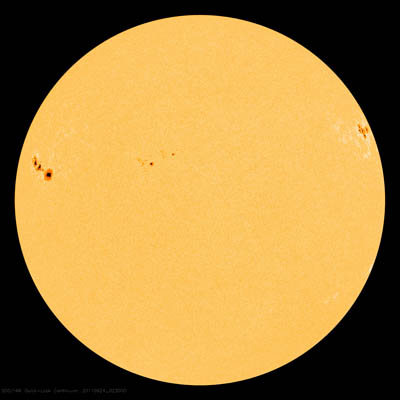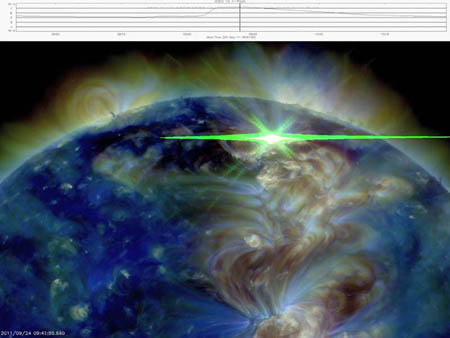Every three hours throughout the day, magnetic observatories around the world measure the largest magnetic change that their instruments recorded during that period. Credit: NOAA
As Sunspot 1302 continues to turn towards Earth, NASA has clarified that a strong-to-severe geomagnetic storm (Kp=8) is active, following a CME (coronal mass ejection) at about 8:15am. EDT (12:15 UT) yesterday, 26 September.
The NASA Goddard Space Weather Lab reported a “strong compression of Earth’s magnetosphere”.
“Simulations indicate that solar wind plasma has penetrated close to geosynchronous orbit starting at 9am. Geosynchronous satellites could therefore be directly exposed to solar wind plasma and magnetic fields. High-latitude sky watchers should be alert for auroras after nightfall,” confirmed the space agency yesterday.
So, what is firing up all of this solar activity?
With the sun set to reach the maximum of its 11-year cycle this year, this is causing Sunspot 1302 to turn more towards Earth, especially in recent months.
This activity is increasing the frequency of solar flares that spark aurorae displays similar to the aurora borealis one sees in the northern hemisphere, for example – think of the northern parts of Norway or Alaska.
Solar flares and CMEs
A solar flare is an explosion on the sun that happens when energy stored in twisted magnetic fields (usually above sunspots) is suddenly released.
NASA says such flares produce a burst of radiation across the electromagnetic spectrum, ranging from radio waves to x-rays and gamma-rays.
Massive bursts of solar wind, known as coronal mass ejections (CMEs), or ‘solar burps’, are associated with solar flares.
So far, Sunspot 1302 has already produced two X-flares: X1.4 on 22 September and X1.9 on 24 September.

Sunspot 1302 has already produced two X-flares (X1.4 on Sept. 22nd and X1.9 on Sept. 24th). Each of the dark cores in this image from SDO is larger than Earth, andthe entire active region stretches more than 100,000 km from end to end. The sunspot’s magnetic field is currently crackling with sub-X-class flares that could grow intolarger eruptions as the sunspot continues to turn toward Earth. Credit: NASA/SDO/HMI
Each of the dark cores in this image (above) from SDO is larger than Earth, and the entire active region stretches more than 100,000 km from end to end, says NASA.
The sunspot’s magnetic field is currently crackling with sub-X-class flares that could grow into larger eruptions as the sunspot continues to turn toward Earth, the agency has affirmed.
Violent solar flash on 24 September – recorded by NASA
Sunspot 1302 unleashed another strong flare on Saturday morning – an X1.9-category blast at 5:40 am EDT (see image below).
NASA’s Solar Dynamics Observatory (SDO) recorded the extreme ultraviolet flash.
“Since the X1.9-flare, active region (AR) 1302 has unleashed M8.6 and M7.4 flares on 24 Sept.and an M8.8 flare early on 25 Sept. None of the blasts have been squarely Earth-directed, but this could change as the sunspot turns toward our planet in the days ahead. AR1302 is growing and shows no immediate signs of quieting down,” said NASA.

Active Region 1302 unleashes an X1.9-category solar flare at 5:40 am EDT on Sept. 24, 2011. NASA’s Solar Dynamics Observatory (SDO) recorded the extremeultraviolet flash in composite wavelengths (211, 193, 171 angstrom). Note: The sun has been rotated 90 degrees clock-wise for better video presentation. Credit:NASA/SDO/GOES